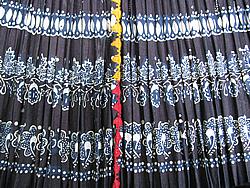Oľga Danglová
Blueprint – fabric dyed in blue with indigo with printed patterns protruding from the base in contrasting, mostly white colour, has gained immense popularity in l7th century with European aristocratic societies. It was a long journey to get from India in order to naturalize in Europe.
Blueprint in Slovakia domesticated in the late 18th century, when became a common article and gradually established itself as a typical clothing of a general population in small towns. By the time it ceased to be fashionable goods with propertied classes it penetrated into small-town clothes.
The 19th century was the greatest period of prosperity of the blueprint craft in Slovakia. Dyeing workshops were almost in every town at that time. Blueprint begins to emerge in rural areas since the mid-19th century, where it becomes available and affordable for rural customers.
The blueprint was undeniable advantageous against white clothing made of domestically produced cloth, originally widespread used among the peasants. Blueprint fabric was easier to preserve, less stained, when cutting parts of clothing it was no longer necessary to adjust the size to the home woven canvas limited by by the width of the loom. They could use more complex cuts. All these were the incentives that led to the expansion of blueprint and its use even where home made linen or hemp fabric was favoured.
Blueprint greatly influenced the culture of peasant clothing and overall composition especially women’s clothing units. It had the regional and local differentiation, created variations according to local standards and aesthetic habits. They made of it various parts of women´s and girl’s clothing – aprons, skirts, headscarves, big scarves on the shoulders, but also jackets, blouses to be worn to work, dressed for festive or ceremonial occasion.
